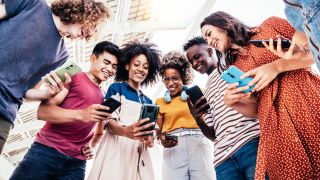Anxiety
Why Gen-Zers Keep Their Phones on 'Do Not Disturb'
These days, impromptu phone calls are regarded as an intrusion.
Posted May 23, 2024 Reviewed by Michelle Quirk
Key points
- Increased digital interactions have paradoxically led to a greater avoidance of real-time communication.
- Phone calls leave room for errors whereas asynchronous communication allows an increased sense of control.
- Real-time social interactions and being witnessed by other humans are essential to our mental health.

Smartphones have changed our lives in many ways, making it easier to stay connected, yet, paradoxically, they have made it more common to avoid communication as well.
For Gen-Zers, owning a landline telephone is unimaginable, let alone the inflexibility of being tethered to a wall. The surprise element of having no idea who is calling feels destabilizing and anxiety-provoking (Collins, 2024).
Many young adults choose to keep their phones on "Do Not Disturb," silencing all incoming alerts. This is partly done as a means of blocking spam calls and avoiding phone scammers, but it also is a way to mitigate social anxiety. Muting calls creates a buffer against unwanted communications and potential social pressures.
Considering Gen-Zers are the most digitally savvy generation, the fact that they are unreachable via phone seems contradictory. This generation, driven by a fear of missing out (FOMO), is highly active across numerous social media platforms and chat groups and is often engaged in multiple conversations at the same time.
An organic conversation requires setting clear boundaries, self-advocacy, managing other people’s idiosyncrasies, and navigating awkward pauses. It is more uncomfortable to have to decline an invitation on the spot than to turn someone down via text.
Unlike previous generations, Gen-Zers were born into a world dominated by smartphones and social media and are very comfortable in front of the camera. They would rather send a video of themselves or a voice recording as an outlet for self-expression than have a real-life phone conversation.
A survey from 2019 done by Face for Business, a U.K. telephone answering service, found that 70 percent of millennials and Gen-Zers experience anxiety when answering the phone (Sebah 2021).
Technology is reshaping human interaction and changing cultural norms.
Amid our demanding and busy lives, we often do not have the bandwidth, time, or energy for phone calls. Social and digital media are increasingly filling this gap, becoming a critical medium for remaining connected, informed, and entertained. They offer a more convenient way to engage with the world, as they have become a seamless, integral part of our daily routines.
For Gen Zers, impromptu phone calls are viewed as an intrusion—the narrative is "How dare you feel entitled to cold call me when you can use the same device to text me!" A cold call feels like gambling with a blind pack: It is impossible to estimate what the demands will be, how much emotional investment the interaction will require, and how much time it will take.
Younger generations view phone calls as a means of communicating in an emergency, rather than a way of connecting. It is more and more becoming a practice to let the call ring out and then send a follow-up text to check-in. Many people schedule a phone call and are more likely to use a video platform.
A survey conducted by Ofcom, the U.K.’s Office of Communications, in 2017 found that only 15 percent of 16- to 24-year-olds prefer phone calls, and 36 percent of them favor instant messaging (Dawson, 2017).
Day-to-day communications are more often done through messaging or voicemail. Phone calls leave no room for errors, but while texting, you can edit your messages later or delete them forever. Asynchronous communication allows for a sense of control, time to curate responses, and the convenience of multitasking. It also serves to alter the timing of the communication, to avoid being pressured into something, and to give difficult topics the opportunity to fizzle out.
Through messaging, it’s easier to avoid challenging topics and draw boundaries. Not replying to texts has become more and more acceptable as well, and the use of GIFs or memes to express oneself allows for deflating anxiety and makes the conversation feel more entertaining.
Dealing with other people is part of being human.
The world is largely digitalized, as many of our day-to-day tasks, from paying our bills to scheduling a doctor’s appointment, are completed through automated calls. We spend so much of our time waiting on hold being told that our "call is important" and that "the next representative will be with [us] shortly."
The cost-cutting measures of automating interactions by businesses come at a high human experience price. Face-to-face conversations are becoming increasingly debilitating and causing anxiety. Young people today have higher rates of anxiety, depression, suicide, and loneliness (Goodwin et al. 2020).
Like any other skill, social interaction requires patience and intentional effort. Gen-Zers, having had fewer opportunities to develop phone etiquette, often feel uncomfortable answering calls, creating a self-perpetuating cycle of avoidance. While younger generations are more comfortable in having conversations about mental health, they also face significant challenges in this area.
As the world evolves, our fundamental human need for connection remains constant. Regardless of the medium, we will always find ways to communicate with one another. Real-time social interactions and having the ability to express ourselves while being witnessed by other humans are essential to our mental health and survival.
If you or someone you love is contemplating suicide, seek help immediately. For help 24/7, dial 988 for the 988 Suicide & Crisis Lifeline, or reach out to the Crisis Text Line by texting TALK to 741741. To find a therapist near you, visit the Psychology Today Therapy Directory.
References
Balan, D (2024). Confidently Chill: An Anxiety Workbook for New Adults. Routledge.
Collins, A (May 2024). How 'Phone Anxiety' Divides Gen Z, Millennials and Boomers. Newsweek.
Dawson, A (Nov 2017). So Generation Mute doesn’t like phone calls. Good. Who wants to talk, anyway? The Guardian.
Goodwin RD, Weinberger AH, Kim JH, Wu M, Galea S. Trends in anxiety among adults in the United States, 2008-2018: Rapid increases among young adults. J Psychiatr Res. 2020 Nov; 130:441–446.
Lyngdoh, T., El-Manstrly, D., & Jeesha, K. (2023). Social isolation and social anxiety as drivers of Generation Z's willingness to share personal information on social media. Psychology & Marketing, 40, 5–26.
Sebah, I. (Feb 2021). Phone call anxiety: why so many of us have it, and how to get over it. The Conversation.




